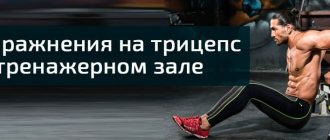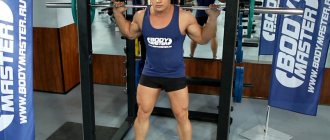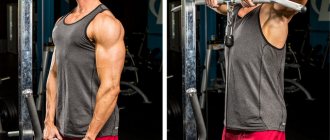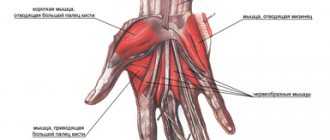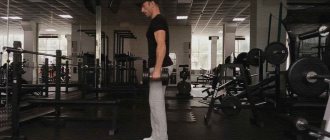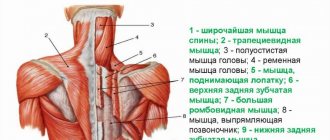The neck muscles are a very important element of our body. After all, this is what keeps our head on our shoulders! The topic of the post is exercises for the neck. I will not only tell you about the exercises, but also show you how to put them together into a complex. You want to build a strong neck, right? Proper neck training is very pleasant and healthy! It improves vision, hair, hearing, sharpens the sense of smell and taste, as it activates blood circulation in the head area.
The neck muscles develop quite quickly and easily. And you don't need to lift heavy weights to do this. A moderate load until you feel tired is quite enough. And if you need a very strong neck, you can easily achieve this result by simply increasing the resistance force and load in the given exercises. Gradually.
The main rule of neck training. Neck exercises must be balanced. This means that it is necessary to train all the muscles of the neck equally: back, sides and front. Violation of this balance will certainly lead to disorders in the cervical spine.
Neck muscles. Basic information.
As you know, all muscles are attached by tendons to bones. And there is a very important anatomical rule that determines the size of the muscles of the entire body. The wider the attachment points of muscles to bones, the more powerful the muscles. Wide places of muscle attachment are usually observed in people with wide bones (hypersthenics, mesomorphs - see body types). Although there are exceptions.
As for the neck muscles, most of them, which determine the width of the neck and its power, are attached to the occipital part of the skull. So, the wider this part of a person is, the more powerful his neck. The same rule applies to the bones of the chest, shoulder blades, and collarbones, to which the neck muscles are attached. In addition, neck power depends on muscle structure. In people whose muscles have long bellies and short tendons, the muscles of the neck, like all other muscles of the body, are initially quite massive. Almost always, the neck muscles are quite powerful in large, massive people.
You've probably noticed that some people don't even need to shake their neck, since it's already wide and powerful. But other people, with a different structure of the occipital part of the skull, cannot achieve such an effect even with intensive training of the neck muscles. It's all about anatomy! And it's hard to do anything about it. More precisely, you don’t need to do anything. You need to take this into account in your expectations! American athlete Jeff King shows us what the neck muscles can be like with extreme development and suitable genetics.
Jeff King's Powerful Neck Muscles
Anatomical aspect
Despite the fact that the neck muscles in bodybuilding are classified as small, from an anatomical point of view, it is a rather complex complex of a large number of muscles.
To keep things simple, in bodybuilding they are divided into three groups:
- Muscles of the anterior part (main – sternocleidomastoid)
- Lateral
- Rear
Anatomy of the neck muscles
Look how many muscles there are in the neck! It consists almost entirely of them. And this is not just like that.
Neck muscles. Front view.
Firstly, the head still weighs quite a lot (about 4-5 kg for an adult), and it needs to be held. Secondly, the neck contains important blood vessels. Most of these vessels are protected in one way or another by muscles. And blood circulation in the head largely depends on the condition of these muscles. Thirdly, the basis of the neck is the cervical spine. And if the neck muscles are poorly developed, there will be trouble. The normal configuration of the cervical spine is disrupted and various problems begin: cervical osteochondrosis, high blood pressure, headaches and a simple ugly violation of posture - cervical hyperlordosis and stoop. This is when a person curls up like a question mark and the head moves forward. The muscles of the neck and back are constantly in unnatural tension. And this always has a bad effect on health and well-being.
Neck muscles. Back view.
It is important to understand that it is necessary not only to develop the neck muscles, but also to develop them evenly. Otherwise, various distortions will occur in the cervical spine. And the situation will be no better than with completely undeveloped muscles.
Thus, you must understand that good neck development is not some kind of excess, but a direct necessity. Everyone needs neck exercises, not just wrestlers, military personnel and ring fighters. Men should definitely have a strong neck. But women should also pay close attention to neck exercises.
Let's start learning the exercises. And below I will tell you how to properly use these exercises in your complex.
Contraindications
The neck is a rather vulnerable part of the body. For this reason, it is not safe for every person to load the muscles in this area. There are a number of contraindications for organizing such training. The main threat is the presence of osteochondrosis. During targeted pumping of the cervical muscles, the course of the disease may become more complicated. They are capable of producing additional unpleasant symptoms.
It is forbidden to shake the neck if there is a tendency to dislocate the vertebrae. In such a situation, you can do a light warm-up. However, it is strongly recommended to avoid complex strength exercises.
To avoid troubles, before starting training, you should visit a doctor for an ultrasound of the cervical spine. Based on the results of the study, the specialist will give clear advice regarding further actions during sports activities.
Isometric exercises for the neck
Isometric exercises are exercises in which the muscles do serious work, but there is no movement of the body or part of it. Isometric muscle work is maintaining a certain body position with fairly strong tension.
These neck exercises are just isometric. We use our own arm strength to apply pressure on the head in different directions. And the neck muscles should resist and prevent your hands from moving your head. Please note that all isometric exercises should be performed with a light to moderate load. Don't apply too much pressure! This may cause injury to the neck area. Increase the load and duration of exercises gradually, from session to session. Never hold your breath when performing isometric exercises. Breathe calmly and rhythmically. Exercises can be performed not only in a standing position, but also in a sitting position.
Front hand pressure
The exercise develops the muscles lying in front of the neck, including the sternocleidomastoid muscle (sternocleidomastoid muscle in the top picture). Stand up straight. Place your hands on your forehead. Apply pressure on your forehead in a backward direction. It is optimal to apply pressure in the eyebrow area. Use your neck muscles to resist this pressure. The exercise is performed for 10 counts. They pressed gently and counted to ten. We rested. Then they repeated it again. Perform no more than 3 approaches with a pause of 30 seconds.
Neck exercise – front hand pressure
Hand pressure on the back of the head
This exercise develops the muscles in the back of the neck, which pull the head back. They are the strongest. The long back muscles also work actively here. While performing the exercise, you may even feel tension in the thoracic spine and even in the lower back. No surprise!
While standing, place your hands with your palms on the back of your head. Apply pressure with your hands forward, trying to tense your neck muscles to prevent your head from moving. It is optimal if you apply pressure to the back of the head at approximately the level of the eyes or bridge of the nose. Pressure duration is 10 seconds (10 counts). Perform 3 sets with a pause of 30 seconds.
Hand pressure on the back of the head
Side hand pressure
This exercise develops the lateral muscles of the neck, making it visually wider. Press your palm into the area above your ear. Apply pressure with your hand and resist with the force of your neck muscles. Do the exercise for 10 counts. Then apply pressure with your other hand for 10 seconds. Repeat 2-3 times.
Apply pressure with your left hand
Apply pressure with your right hand
Why pump your neck?
The question of why a pumped neck is needed is often asked by beginners who are just starting to visit the gym and begin intense sports activities. The answer here is obvious. The defining moments are the harmonious development of the muscles of the whole body, beauty and maintaining good health.
Many people are engaged in sedentary work in an office chair every day. An inflated neck makes it possible to prevent the development of osteochondrosis of the upper spine. Strengthening local muscles protects against the formation of a persistent pain syndrome when you have to sit in an uncomfortable position for a long time.
Strong neck muscles are able to reliably maintain the balance of the head. Pumped muscles are not at risk of injury when performing sharp turns and bends.
Dynamic exercises for neck muscles
These exercises are performed using additional weight (a barbell plate or a special device for the head).
Head lifts while lying face down
The exercise develops the back muscles of the neck and back muscles along the spine.
Lie face down on a bench with your head hanging down. Place the pancake on the back of your head, holding it with your hands. You can wrap the pancake in a towel. Lower and raise your head. Perform 2-3 sets of 12-20 repetitions. The optimal weight for beginners is about 5 kg, perhaps a little more. Rest between sets for about 1 minute.
Head lifts while lying face down. Initial position.
Head lifts while lying face down. Finish.
Head lifts while lying face up
The exercise develops the muscles of the front of the neck and seriously reduces stoop.
Lie face up on a bench with your head hanging down. Place the pancake on the bridge of your nose, holding it with your hands. You can wrap the pancake in a towel or place a small towel under it. Gently raise and lower your head, overcoming the weight of the pancake. Perform 2-3 sets of 12-20 repetitions. The optimal weight of the pancake for beginners is 2.5 kg. Rest between sets is about 1 minute.
Head lifts while lying face up. Initial position.
Head lifts while lying face up. Finish.
Seated head raises with additional load
The exercise requires a special head strap with a chain and a carabiner to secure the load. Place the strap on and adjust its size until it fits snugly. Attach a weight plate or dumbbell. The optimal weight for a beginner in this neck exercise is about 5 kg. Sit down and place your hands on your knees. Bend your head forward, and then overcome the weight of the load by raising your head. Perform 2-3 sets of 12-20 repetitions. Rest between sets for 30-60 seconds.
This exercise not only develops the neck muscles, but also strengthens the back and improves posture. However, if you have cervical hyperlordosis, this exercise is not for you.
Sitting head raises with additional cargo Initial position.
Sitting head raises with additional cargo Finish.
Head lifts while lying on your side
This exercise develops the side and back muscles of the neck and the muscles along the spine. Lie on the bench sideways, take a stable position. Place a pancake on the ear area (you can put a towel). Move your head smoothly up and down. Perform 2-3 sets of 12-20 reps. The recommended weight of the pancake for beginners is no more than 2.5-5 kg. Don't rest between sets. Just roll over and repeat the exercise on the other side of your neck. Keep alternating until you complete all the approaches.
Head lifts while lying on your side with extra. cargo
Contraindications and precautions (including osteochondrosis)
The neck is one of the most vulnerable places in a person. It can be injured without even playing sports. Before you start training your neck, you must be sure that you have no contraindications for this:
- You should not put any strain on your neck if you have appropriate contraindications from your doctor;
- if you have had injuries to the spine or neck muscles (for example: osteochondrosis), then you also need to consult a doctor before starting training; most likely, you will have to choose exercises very carefully and perform them carefully, avoiding unnecessary stress;
- if you have a sedentary lifestyle, you haven’t exercised for a long time or are far from sports at all, then your neck is too weak to withstand heavy loads; in this case, you should not exercise with weights, but it is better to do a simple warm-up several times a week, at least at first;
- If you already have experience in sports, but have never trained your neck, you should start with light weights.
If you decide to pump up your neck, and you have no contraindications for this, nevertheless, observe the following precautions:
- start your workout with a warm-up, and at the end don’t forget to do a few final stretching and relaxation exercises;
- the correct choice of loads is important, since heavy weight can cause serious injury;
- you need the right equipment: a special head strap, a soft covering under your head or a towel;
- The correct technique for doing the exercises is important, otherwise there is a risk of damaging the cervical vertebrae;
- Do not exceed the number of recommended approaches and repetitions, otherwise you also risk injury;
- all exercises must be performed without sudden movements, smoothly;
- During the exercises, monitor your sensations, stop the exercise if you feel pain.
Indirect neck exercises
These are exercises in which the neck muscles receive indirect load. And the purpose of these exercises is to develop other muscles, however, the neck muscles also develop well. As a rule, exercises for the trapezius muscles have a good effect on the development of neck muscles. And this is not surprising! After all, the cervical and trapezius muscles work in one ligament.
Shrugs with dumbbells or barbell
The exercise is performed with dumbbells or a barbell held in lowered hands. Raise and lower your shoulders without bending your elbows. At the same time, move your shoulders back a little. This will increase the impact on the trapezius muscles. Many athletes recommend that when using significant weight (25 kg or more in each hand) keep your head slightly tilted forward to avoid pinching and increase the amplitude of shrugs.
Shrugs with a barbell
Shrugs with a barbell
Side plank
And this exercise is not at all intended for the neck muscles. However, they actively work and develop, since in the plank position we are forced to keep our heads hanging. The lateral neck muscles get a very good workout if you stand in the side plank for 30-60 seconds or more.
The side plank exercise is great for training your neck muscles.
Lying straight leg raises
Leg raises are designed to train the abdominal and thigh muscles. However, if you keep your head up, this is an excellent workout for the anterior neck muscles. By the way, I prescribe this exercise to people with cervical hyperlordosis and slouching to balance their overly tight posterior neck muscles and thoracic spine.
Leg lifts are done smoothly. When raising your legs, exhale, when lowering, inhale. Usually perform 3 sets of 15-30 repetitions.
Lying straight leg raises. Start.
Lying straight leg raises. Finish.
Workouts in the gym and at home
If your gym does not have a special exercise machine, then pumping up your neck will not be much different from home workouts. It’s just that it’s easier to find an assistant here who will “push” her through.
It is rational to use exercises using resistance to the assistant’s hands, flexion and extension with weights and in the simulator.
At home, the most accessible movements are wrestling exercises or movements with a harness.
You can also perform flexion and extension of the neck while lying down with a weighting agent, for which you can use improvised means.
Neck muscle stretch
It is beneficial to regularly stretch your neck muscles. But this must be done very carefully, without excessive effort. Stretch your neck muscles until you feel comfortable, but not stronger. After stretching, you should feel a sense of lightness and a pleasant warmth in the neck area.
Posterior neck stretch
The exercise is performed standing, sitting on a chair, or sitting on the floor if flexibility allows. In any case, keep your back straight. Place your hands on the back of your head and gently tilt your head forward, feeling a stretch in the back of your neck. Hold the stretched position for 5-15 seconds. Then carefully return to the starting position. Perform 2-3 such approaches. Rest between sets for 15-30 seconds.
This stretch is especially recommended if you have a stooped posture and cervical hyperlordosis.
Stretching the back muscles of the neck while sitting on the floor. Initial position.
Stretching the neck muscles while sitting on the floor
Side neck stretch
Stand up straight. Place your hand on the opposite side of your head. Tilt your head towards your working arm, trying to reach your ear with your shoulder. Gently help the tilt with your hand. Feel the stretch on the opposite side of your neck. Hold the stretched position for 5-10 seconds. Then stretch the other side. Repeat the exercise 2-3 times for each side.
Side neck stretch
Rolls while lying down
How to pump up your neck? Rolls are one of the most effective exercises. The training is as follows:
- Take a supine body position on a gymnastic mat. The pelvis is raised at an angle of about 30°, resting on the feet. In the upper part, the body is slightly supported by the shoulder blades.
- Perform smooth rolls with the head, starting from the lower part of the neck. The end point of the movement is the back of the head.
- Next they roll over onto their stomach. They rest their foreheads on the gymnastics mat. Roll forward and backward with emphasis on the head. The opposite end points of the movements are the crown and nose. The palms are placed in the chest area and are used to support balance.
How to pump up your neck muscles?
I already mentioned that the neck muscles develop quite easily. And for this you don’t need to train them intensively. Moderate regular exercise is sufficient. Sometimes you can do a little more serious training. But it is important to consider that you cannot build powerful neck muscles if your overall weight is too low. This is a general law of training. You can't strengthen any one muscle without increasing the overall muscle mass of your entire body. What might a set of exercises for the neck look like?
A set of exercises for the neck
- Hand pressure on the back of the head for 3x10s (gradually increase the time to 15-20s, and increase the pressure slightly)
- We apply pressure with our hands in front 3x10s (recommendations are similar to the first exercise)
- Side hand pressure 3x10s (similar)
Insert this small complex at the very beginning of your strength training, immediately after your warm-up. It only takes a few minutes, but it will help you avoid problems when training with heavy weights. And at the end of your strength training, insert a neck stretch.
How many times a week should you exercise your neck muscles? If the workout is isometric, do it at least every day. But if you feel that your neck muscles do not have time to recover, do neck training less frequently, 3-4 times a week. If you use dynamic exercises with additional weight, shake your neck no more than 3 times a week.
You can choose any other exercises given in this article. But remember that you need to train all sides of the neck. For balance. And if you have cervical hyperlordosis, focus on stretching the back muscles of the neck and developing the front ones.
Pumping the neck under the weight of your own body
How to pump your neck, putting stress on local muscles under the pressure of your body weight? The training involves the following:
- Take an emphasis while lying down, raising yourself on your arms with your palms under the shoulder girdle.
- Legs spread wide.
- The crown of the head rests on a gymnastic mat laid out on the floor.
- Remove the support from your hands, point your pelvis up, and keep your back straight.
- The head begins to roll to the right and left, back and forth, avoiding circular movements.
- Carry out up to 20 repetitions of movements in separate directions.
Unprepared people often fail to immediately withstand the above loads. To make the exercise easier, it is enough to provide slight support to the neck muscles by lightly resting your palms on the floor. Experienced athletes, on the contrary, are recommended to place their hands behind their backs, supporting themselves in only three points - on the tips of their toes and their head.
Preparation for classes
Before you start doing neck exercises, you need to do a preparatory warm-up. It helps warm up the muscles and prevent sprains.
The most suitable exercises for warming up:
- Tilts in different directions.
- Turns left and right. You should try to touch your ear to your shoulder.
- Rotational movements to the left and to the right.
- To warm up the side muscles, you need to raise your arm up, bend it at the elbow and reach for the ear on the other side.
- For the neck muscles in front, make a lock with your fingers and move them to the back of the head. While holding your head, bend backwards.
- For the back muscles of the neck, you need to rest your palms on your forehead and try to bend forward.
All exercises are done at a slow and calm pace. You cannot make sudden movements and increase speed. If you do not follow simple rules, severe pain may occur.
Exercises are performed 5-7 times. When performing them, you need to feel the tension and tension of the muscles. Warm-up duration is 3-5 minutes.
Examples of ready-made programs
Before starting a workout, be sure to warm up.
You can strengthen your neck muscles at home using the following program:
- Performing weighted head lifts. Performed lying on a bench 10-12 times. First, the starting position is lying on your back, then on your stomach and on both sides.
- Shrugs with dumbbells. Take dumbbells of the same weight. Lower your arms along your body and raise your shoulders as high as possible.
- Lifting dumbbells in front of you. Stand up straight, dumbbells in your hands, hands down. Exhale and raise your arms in front of you, then to shoulder level and in front of you, without bending your elbows. Inhale and slowly return to the starting position.
- Raising dumbbells to the sides. The exercise is performed as the previous one, only the arms move to the sides.
- These exercises are repeated 6-12 times. Take a break of 2-3 minutes between exercises.
Warm-up before neck muscle training
Whatever muscle group we work on, we first need to do a warm-up, and the neck muscles are no exception. Warm-up is necessary in order to warm up the muscles, disperse the blood, and avoid injuries, muscle spasms and overexertion.
Warm-up for the neck muscles is familiar to all of us from school physical education lessons. These are standard head turns left and right, head tilts up and down, circular rotations of the head in different directions, and so on.
When doing the warm-up, try to keep all your movements smooth and calm, do not rush, do not chase the speed of the exercise, otherwise you will only harm yourself. Do not perform more than five repetitions of each exercise on one side, as this can also lead to negative consequences.
